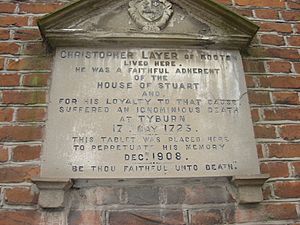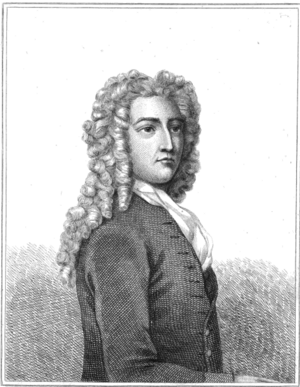Christopher Layer facts for kids
Christopher Layer (1683–1723) was an English man who was involved in a secret plan to bring back the old royal family (the Stuarts) to the throne. This kind of plan was called a 'Jacobite' plot. He was found guilty of a very serious crime against the government, called 'high treason,' and was punished for it in 1723. His actions were part of a bigger event known as the Atterbury Plot.
His Early Life
Christopher Layer was born on November 12, 1683. His father, John Layer, worked as a seller of lace in London. Christopher was raised by his uncle, also named Christopher Layer, who was a country gentleman in Norfolk.
His uncle sent him to Norwich grammar school. After school, he worked with a lawyer named Repingale in Aylsham, Norfolk.
Later, his uncle faced financial problems. He offered to give Christopher his remaining property in exchange for money and regular payments. Christopher agreed to the deal but then refused to make the payments. Soon after, he had a disagreement with his boss and moved to London. There, he became a qualified lawyer. He returned to Norfolk and found work, but then joined the Middle Temple, which is one of the places where lawyers are trained. He officially became a barrister, which is a type of lawyer who can argue cases in court.
Becoming a Jacobite Plotter
Christopher Layer worked as a legal advisor for Lord North and Grey, who was known for supporting the Jacobite cause. Layer himself was a strong Jacobite. He hoped that if the Stuart family returned to power, he would become a very important judge, like the Lord Chancellor.
In the summer of 1721, Layer traveled to Rome. There, he met with the Old Pretender, who was the Stuart claimant to the throne. Layer told him about a secret plan. He suggested gathering former soldiers and taking control of important places in London. These included the Tower of London, where valuable things were kept, and the Bank of England, which handled the country's money. He also planned to take control of the royal family and remove key government leaders.
Layer claimed he had many followers who would help him. He did meet with some people who supported his ideas at an inn. He also tried to convince soldiers to join his cause. He managed to get a few unhappy people to join his secret group.
His Arrest and Trial
Eventually, Christopher Layer's plans were discovered. Two women who knew him told the authorities about his activities. He was arrested but managed to escape for a short time. However, he was quickly caught again that same evening. He was then held in the Tower of London under strict watch.
His office assistants were also watched, and his wife, Elizabeth Elwin, was brought to London. The case went to the court of King's Bench on October 31, 1722. Layer was brought to the court in chains and had to stand, even though he was ill.
His trial began on November 21. The chief judge ordered Layer's chains to be removed. Among the papers found was a document called the Scheme. This document, which was proven to be in Layer's handwriting, contained instructions for the planned uprising. Evidence also showed that Layer and the Pretender were close. The Pretender and his wife had even agreed to be godparents to Layer's daughter. This was done secretly through other people acting on their behalf.
Layer and his lawyers presented his defense. However, after a trial that lasted eighteen hours, the jury decided he was guilty.
The judge announced his punishment on November 27. Layer, again in chains, tried to argue against the judgment, but he was found guilty of high treason. He was sentenced to the most severe punishment for this crime. He was given extra time before his punishment, hoping he would reveal more information, but he refused to do so. He was also given time to sort out his legal affairs. Christopher Layer was punished on May 17, 1723.



